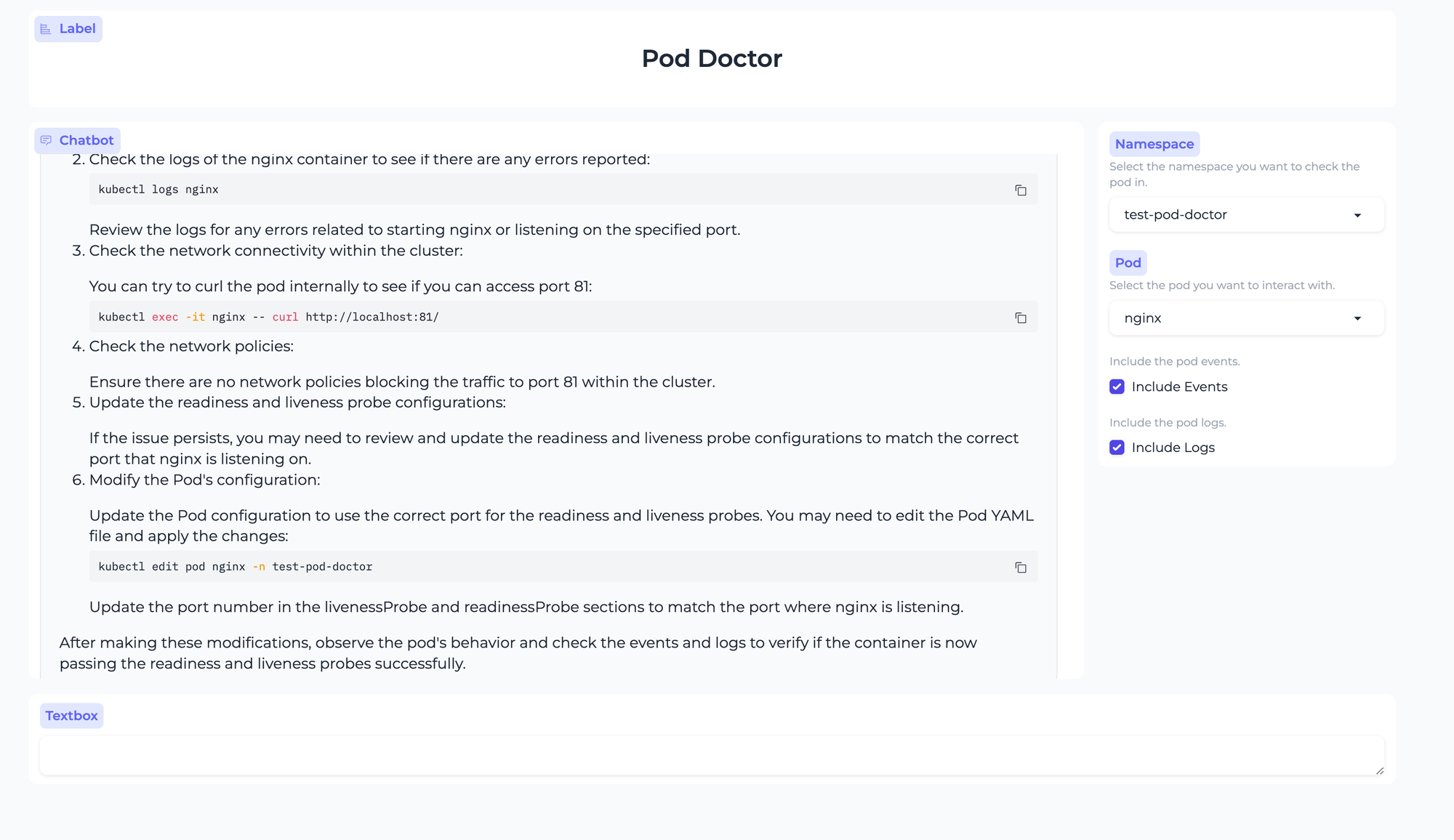Pod Doctor 允许您与 Kubernetes Pod 交互,检索信息并对 Pod 进行故障排除,并从 GPT-4 接收专家见解
译自 Building a Kubernetes Pod Doctor with Gradio and GPT-4,作者 Team CodeReliant。
各位开发者,
和你们中的许多人一样,我一直在探索 AI 如何帮助我提高日常任务的生产力。因此,“Pod Doctor” 诞生了。这是一个小工具(只有 180 行!),它可以帮助我比自己动手更快地解决 Kubernetes Pod 故障。你可以在 github 上找到完整代码,在本入门教程中,我们将逐步了解如何为自己构建类似的工具。
我们将学习如何创建 Gradio 聊天机器人 UI,集成 Kubernetes Python 客户端,并利用 GPT-4 的语言理解和推理能力。
Pod Doctor 应用程序的用户界面使用 Gradio 构建,这是一个用于创建可自定义 UI 组件和部署机器学习模型的 Python 库。该界面包含以下元素:
- 标题: 显示应用程序名称“Pod Doctor”的标签。
- 聊天机器人: 一个聊天机器人风格的界面,用于显示用户和语言模型之间的对话。
- 命名空间下拉菜单: 一个下拉菜单,允许用户选择他们想要交互的 Kubernetes 命名空间。
- Pod 下拉菜单: 一个下拉菜单,其中填充了所选命名空间中可用的 Pod 列表。
- 包含事件复选框: 一个复选框,允许用户在提供给语言模型的信息中包含 Pod 事件。
- 包含日志复选框: 一个复选框,允许用户在提供给语言模型的信息中包含 Pod 日志。
- 消息输入: 一个文本输入字段,用户可以在其中输入他们的消息或查询。
with gr.Blocks(theme=gr.themes.Soft()) as demo:
with gr.Row():
title = gr.Label("Pod Doctor")
with gr.Row():
with gr.Column(scale=4):
chatbot = gr.Chatbot(height="600px")
with gr.Column(scale=1):
namespace = gr.Dropdown(
list_namespaces(),
label="Namespace",
info="Select the namespace you want to check the pod in.",
interactive=True,
)
pod = gr.Dropdown(
[],
label="Pod",
info="Select the pod you want to interact with.",
interactive=True,
)
include_events = gr.Checkbox(
label="Include Events",
info="Include the pod events.",
interactive=True,
)
include_logs = gr.Checkbox(
label="Include Logs",
info="Include the pod logs.",
interactive=True,
)
namespace.change(namespace_change, inputs=namespace, outputs=pod)
with gr.Row():
msg = gr.Textbox()
def respond(message, chat_history, namespace, pod, include_events, include_logs):
if not namespace or not pod or not message:
chat_history.append((message or "Error", "Please select a namespace and pod."))
return "", chat_history
bot_message = call_llm(message, namespace, pod, include_events, include_logs)
new_message = f"Namespace {namespace}, Pod: {pod}, Include Events: {include_events}, Include Logs: {include_logs} \n {message}"
chat_history.append((new_message, bot_message))
return "", chat_history
msg.submit(respond, [msg, chatbot, namespace, pod, include_events, include_logs], [msg, chatbot])随着我们继续学习本教程,你可能会遇到尚未定义的函数调用。但是,这些函数将在我们继续前进时进行解释和实现。
让我们定义一个函数,该函数负责在选择命名空间后更新 Pod 的下拉菜单:
def namespace_change(value):
"""
Returns a Dropdown widget populated with a list of pods based on the given value.
Args:
value (str): The namespace to filter the pods.
Returns:
gr.Dropdown: A Dropdown widget with choices populated from the list of pods.
"""
pods = list_pods(value)
return gr.Dropdown(choices=pods)Pod Doctor 应用程序使用 kubernetes Python 库 与 Kubernetes 集群集成。以下函数处理与 Kubernetes API 的交互:
首先,我们需要导入 k8s 库并加载配置:
from kubernetes import client, config
config.load_kube_config()list_namespaces():从 Kubernetes 集群中检索命名空间列表。
def list_namespaces():
"""
Retrieves a list of namespaces from the Kubernetes cluster.
Returns:
A list of namespace names.
"""
v1 = client.CoreV1Api()
namespaces = v1.list_namespace()
return [namespace.metadata.name for namespace in namespaces.items]list_pods(namespace):列出指定命名空间中的所有 Pod。
def list_pods(namespace):
"""
List all pods in the specified namespace.
Args:
namespace (str): The namespace to list pods from.
Returns:
list: A list of pod names.
"""
v1 = client.CoreV1Api()
pods = v1.list_namespaced_pod(namespace)
return [pod.metadata.name for pod in pods.items]get_pod_info(namespace, pod, include_events, include_logs): 检索有关特定 Pod 的详细信息,包括事件和日志(如果需要)。
def get_pod_info(namespace, pod, include_events, include_logs):
"""
Retrieves information about a specific pod in a given namespace.
Args:
namespace (str): The namespace of the pod.
pod (str): The name of the pod.
include_events (bool): Flag indicating whether to include events associated with the pod.
include_logs (bool): Flag indicating whether to include logs of the pod.
Returns:
dict: A dictionary containing the pod information, events (if include_events is True), and logs (if include_logs is True).
"""
v1 = client.CoreV1Api()
pod_info = v1.read_namespaced_pod(pod, namespace)
pod_info_map = pod_info.to_dict()
pod_info_map["metadata"]["managed_fields"] = None
info = {
"PodInfo": pod_info_map,
}
if include_events:
events = v1.list_namespaced_event(namespace)
info["Events"] = [
{
"Name": event.metadata.name,
"Message": event.message,
"Reason": event.reason,
}
for event in events.items
if event.involved_object.name == pod
]
if include_logs:
logs = v1.read_namespaced_pod_log(pod, namespace)
info["Logs"] = logs
return infoPod Doctor 应用程序的核心是与 OpenAI 的 GPT-4 语言模型集成。
call_llm 函数 负责根据用户的留言、选定的命名空间、Pod 以及包含事件和日志的选项生成响应。
以下是 call_llm 函数的工作原理:
- 调用 get_pod_info 函数来检索 Pod 信息,包括事件和日志(如果需要)。
- create_prompt 函数通过将用户的消息与 Pod 信息相结合来生成提示消息。
- 使用 openAiClient.chat.completions.create 方法调用 OpenAI API,传递提示消息和 GPT-4 模型。
- 返回语言模型的响应,并在聊天机器人界面中显示。
from openai import OpenAI
import yaml
openAiClient = OpenAI()
def create_prompt(msg, info):
"""
Creates a prompt message with the given message and pod information.
Args:
msg (str): The main message for the prompt.
info (dict): A dictionary containing pod information.
Returns:
str: The generated prompt message.
"""
prompt = f"{msg}\n"
prompt += f"Pod Info: \n {yaml.dump(info['PodInfo'])} \n"
if info.get("Events"):
prompt += f"Here are the last few events for the pod: \n"
for event in info["Events"]:
prompt += f"Event: {event['Name']}, Reason: {event['Reason']}, Message: {event['Message']}\n"
if info.get("Logs"):
prompt += f"Here are the last few logs for the pod: \n"
prompt += info["Logs"]
return prompt
def call_llm(msg, namespace, pod, include_events, include_logs):
"""
Calls the Language Model to generate a response based on the given message, namespace, pod, and options.
Args:
msg (str): The user's message.
namespace (str): The namespace of the pod.
pod (str): The name of the pod.
include_events (bool): Whether to include events in the pod information.
include_logs (bool): Whether to include logs in the pod information.
Returns:
str: The generated response from the Language Model.
"""
info = get_pod_info(namespace, pod, include_events, include_logs)
prompt = create_prompt(msg, info)
completion = openAiClient.chat.completions.create(
model="gpt-3.5-turbo",
messages=[
{"role": "system", "content": "You are a kubernetes expert, and will help the user with request below based on the context and info provided"},
{"role": "user", "content": prompt}
]
)
return completion.choices[0].message.content我们需要一段代码将所有内容包装在一起:
if __name__ == "__main__":
demo.launch()export OPENAI_API_KEY='sk-xxxxxxxxxx'
python app.py要使用 Pod Doctor 应用程序,请按照以下步骤操作:
- 确保已设置本地 Kubernetes 配置,请尝试 kubectl cluster-info
- 从“命名空间”下拉列表中选择所需的 Kubernetes 命名空间。
- 从“Pod”下拉列表中选择要交互的 Pod。
- 可选:如果要将 Pod 事件和日志包含在提供给语言模型的信息中,请选中“包含事件”和“包含日志”复选框。
- 在文本输入字段中键入您的消息或查询,然后按 Enter。
- 该应用程序将在聊天机器人界面中显示 GPT-4 语言模型的响应。
让我们尝试部署一个探测配置中端口错误的 Pod,并要求 Pod Doctor 为我们进行故障排除。
以下是我们将应用的错误 nginx Pod:
apiVersion: v1
kind: Pod
metadata:
name: nginx
spec:
containers:
- name: nginx
image: nginx
ports:
- containerPort: 80
livenessProbe:
httpGet:
path: /
port: 81
readinessProbe:
httpGet:
path: /
port: 81应用此 yaml 后,我们转到我们的应用程序,选择我们应用它的命名空间,选择包含事件和日志,并在文本框中输入 troubleshoot,按 Enter 键,然后见证奇迹:
正如我们所见,Pod Doctor 能够成功对 Pod 进行故障排除,并提供根本原因解决方案。
通过结合Gradio的强大功能来构建用户界面,Kubernetes Python 库 来与 Kubernetes Pod 交互,以及 GPT-4 的高级语言理解能力,Pod Doctor 应用程序提供了一种强大且直观的方式来与 Kubernetes Pod 交互并对其进行故障排除。
您可以在github中找到完整代码。


